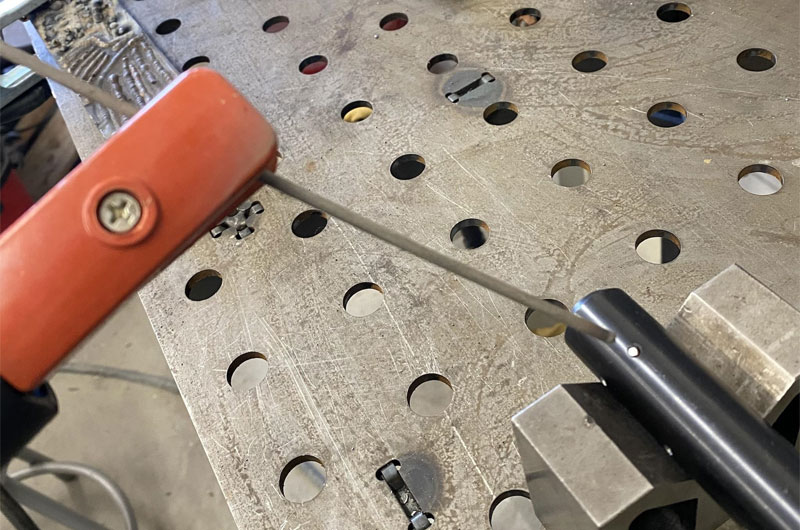One of the most valuable attributes of stick welding is its ability to join a wide variety of metals, ranging from common carbon steel to exotic alloys.
However, each type of metal comes with unique challenges and requires specific techniques, electrodes, and considerations to achieve quality welds.
In this article, we will explore how stick welding is applied to different metals.
1. Stick Welding Carbon Steel
Carbon steel is the most commonly welded metal using stick welding. It has good weldability due to its relatively low carbon content (generally below 0.30%), which reduces the risk of cracking.
The most widely used electrodes for carbon steel are E6010, E6011, E7018, and E7014.
- E6010 and E6011 electrodes provide deep penetration, making them suitable for root passes and welding in various positions.
- E7018 is a low-hydrogen electrode known for producing strong, ductile welds with excellent mechanical performance.
Tips for Stick Welding Carbon Steel
- Preheat is generally not required for low carbon steel but may be necessary for thicker sections or high-carbon steels.
- Thoroughly clean the surface to eliminate rust, paint, and oil before starting the weld.
- Use a proper travel speed and maintain a short arc length to avoid undercut and slag inclusions.
2. Stick Welding Stainless Steel
Stainless steel presents more complexity due to its alloy content, which includes chromium and nickel. While alloying elements improve corrosion resistance, they also increase the risk of thermal distortion and cracking.
For stainless steel, use electrodes such as E308L-16, E309L-16, or E316L-16, chosen based on the grade of stainless being welded:
- E308L is suited for 304 and similar grades.
- E309L is used when joining stainless to mild steel.
- E316L is preferred for stainless with molybdenum (such as 316).
Tips for Stick Welding Stainless Steel
- Limit heat input to prevent carbide precipitation, which can lead to corrosion.
- Keep interpass temperatures low.
- Use stringer beads rather than wide weaves.
- Clean the joint area before and after welding to prevent contamination.
3. Stick Welding Cast Iron
Cast iron is brittle and difficult to weld because its high carbon content makes it prone to cracking.
- Nickel-based electrodes (ENiFe-CI, ENi-CI) are ideal for welding gray or ductile cast iron.
- Steel electrodes like E7018 can be used in some applications but are more prone to cracking.
Tips for Stick Welding Cast Iron
- Preheat the casting to around 500°F (260°C) to reduce thermal shock.
- Slow cooling is crucial—wrap the part in insulating material or allow it to cool in a furnace.
- Apply short welds (stitch welding) and allow cooling between passes to reduce thermal stress.
- Peen the welds lightly to relieve internal stresses.
4. Stick Welding Aluminum (Rare and Difficult)
Stick welding aluminum is not common and is considered difficult due to aluminum’s high thermal conductivity and oxide layer. While MIG and TIG are preferred methods, stick welding aluminum is possible with special techniques.
- E4043 or E4045 aluminum electrodes are available for SMAW, though their use is limited.
- These rods produce a high amount of slag and require high amperage settings.
Tips for Stick Welding Aluminum
- Clean the oxide layer using a stainless steel wire brush.
- Preheat the material to reduce heat loss and improve penetration.
- Use a high AC or DCEN current setting.
- Be prepared for a less aesthetic weld and limited joint strength.
5. Stick Welding Cast Steel
Cast steel is often easier to weld than cast iron, especially if it’s low in carbon. It is used in industrial applications like machinery and construction.
Use low-hydrogen electrodes like E7018 to avoid cracking and porosity.
Tips for Stick Welding Cast Steel
- Preheat if the carbon content is high or the casting is thick.
- Avoid fast cooling to reduce the risk of cracking.
- Perform a test weld if the composition of the steel casting is unknown.
6. Stick Welding Galvanized Steel
Galvanized steel’s zinc coating can emit toxic fumes and compromise weld quality through contamination.
Use E6010 or E6011 for better penetration through the coating.
Tips for Stick Welding Galvanized Steel
- Remove the zinc coating near the weld area using a grinder or torch.
- Use proper ventilation or fume extraction systems to avoid exposure to harmful zinc oxide fumes.
- Expect more spatter and slag due to the coating.
7. Stick Welding High-Strength Low-Alloy (HSLA) Steel
HSLA steels offer high strength and are commonly used in construction and heavy machinery.
Low-hydrogen electrodes like E7018, E8018, or specially designated low-alloy rods based on the specific grade.
Tips for Stick Welding High-Strength Low-Alloy Steel
- Adhere to recommended preheat and interpass temperature settings to avoid cracking.
- Select filler material that closely matches the base metal’s mechanical properties.
- Avoid excessive heat input to maintain the steel’s mechanical properties.
8. Stick Welding Copper and Copper Alloys
Welding copper is difficult because of its high thermal conductivity and tendency to form surface oxides. It requires a lot of heat and special care.
Special copper alloy electrodes, such as those containing silicon bronze (AWS ECuSi), are used for welding copper and its alloys.
Tips for Stick Welding Copper and Copper Alloys
- Preheat copper parts (300–500°F) to reduce heat loss.
- Use high welding currents.
- Remove all oxides and contaminants from the surface to ensure a clean weld area.

